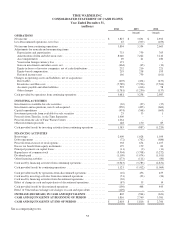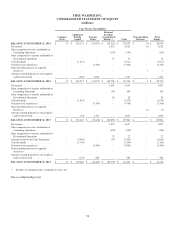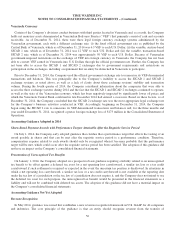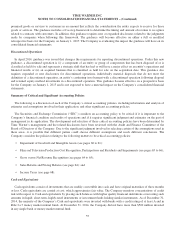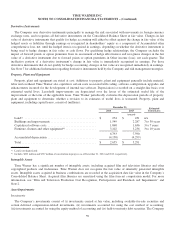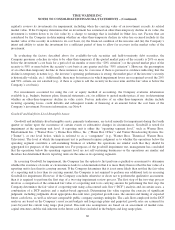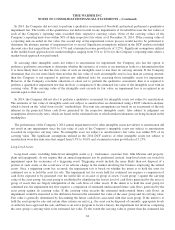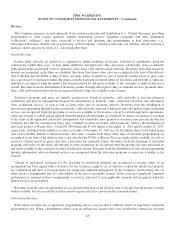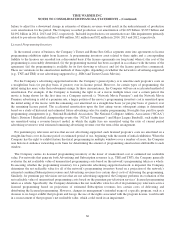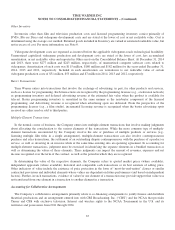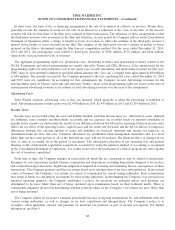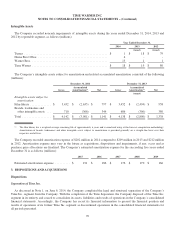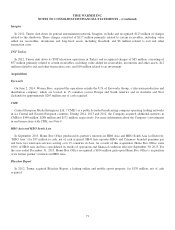Time Magazine 2014 Annual Report Download - page 77
Download and view the complete annual report
Please find page 77 of the 2014 Time Magazine annual report below. You can navigate through the pages in the report by either clicking on the pages listed below, or by using the keyword search tool below to find specific information within the annual report.TIME WARNER INC.
NOTES TO CONSOLIDATED FINANCIAL STATEMENTS – (Continued)
In 2014, the Company did not elect to perform a qualitative assessment of Goodwill and instead performed a quantitative
impairment test. The results of the quantitative test did not result in any impairments of Goodwill because the fair values of
each of the Company’s reporting units exceeded their respective carrying values. None of the carrying values of the
Company’s reporting units were within 30% of their respective fair values as of December 31, 2014. If the carrying value of
a reporting unit exceeded its fair value, the second step of the impairment review process would need to be performed to
determine the ultimate amount of impairment loss to record. Significant assumptions utilized in the DCF analysis included
discount rates that ranged from 9.0% to 9.5% and a terminal revenue growth rate of 3.25%. Significant assumptions utilized
in the market-based approach were market multiples ranging from 9.5x to 12.0x for the Company’s reporting units where a
market-based approach was performed.
In assessing other intangible assets not subject to amortization for impairment, the Company also has the option to
perform a qualitative assessment to determine whether the existence of events or circumstances leads to a determination that
it is more likely than not that the fair value of such an intangible asset is less than its carrying amount. If the Company
determines that it is not more likely than not that the fair value of such an intangible asset is less than its carrying amount,
then the Company is not required to perform any additional tests for assessing those intangible assets for impairment.
However, if the Company concludes otherwise or elects not to perform the qualitative assessment, then it is required to
perform a quantitative impairment test that involves a comparison of the estimated fair value of the intangible asset with its
carrying value. If the carrying value of the intangible asset exceeds its fair value, an impairment loss is recognized in an
amount equal to that excess.
In 2014, the Company did not elect to perform a qualitative assessment for intangible assets not subject to amortization.
The estimates of fair value of intangible assets not subject to amortization are determined using a DCF valuation analysis,
which is based on the “relief from royalty” methodology. Discount rate assumptions are based on an assessment of the risk
inherent in the projected future cash flows generated by the respective intangible assets. Also subject to judgment are
assumptions about royalty rates, which are based on the estimated rates at which similar tradenames are being licensed in the
marketplace.
The performance of the Company’s 2014 annual impairment test for other intangible assets not subject to amortization did
not result in any impairments since the fair value of each of the Company’s intangible assets not subject to amortization
exceeded its respective carrying value. No intangible asset not subject to amortization’s fair value was within 30% of its
carrying value. The significant assumptions utilized in the 2014 DCF analysis of other intangible assets not subject to
amortization were discount rates that ranged from 9.5% to 10.0% and a terminal revenue growth rate of 3.25%.
Long-Lived Assets
Long-lived assets, including finite-lived intangible assets (e.g., tradenames, customer lists, film libraries and property,
plant and equipment), do not require that an annual impairment test be performed; instead, long-lived assets are tested for
impairment upon the occurrence of a triggering event. Triggering events include the more likely than not disposal of a
portion of such assets or the occurrence of an adverse change in the market involving the business employing the related
assets. Once a triggering event has occurred, the impairment test is based on whether the intent is to hold the asset for
continued use or to hold the asset for sale. The impairment test for assets held for continued use requires a comparison of
cash flows expected to be generated over the useful life of an asset or group of assets (“asset group”) against the carrying
value of the asset group. An asset group is established by identifying the lowest level of cash flows generated by the asset or
group of assets that are largely independent of the cash flows of other assets. If the intent is to hold the asset group for
continued use, the impairment test first requires a comparison of estimated undiscounted future cash flows generated by the
asset group against its carrying value. If the carrying value exceeds the estimated undiscounted future cash flows, an
impairment would be measured as the difference between the estimated fair value of the asset group and its carrying value.
Fair value is generally determined by discounting the future cash flows associated with that asset group. If the intent is to
hold the asset group for sale and certain other criteria are met (e.g., the asset can be disposed of currently, appropriate levels
of authority have approved the sale, and there is an active program to locate a buyer), the impairment test involves comparing
the asset group’s carrying value to its estimated fair value. To the extent the carrying value is greater than the estimated fair
61




